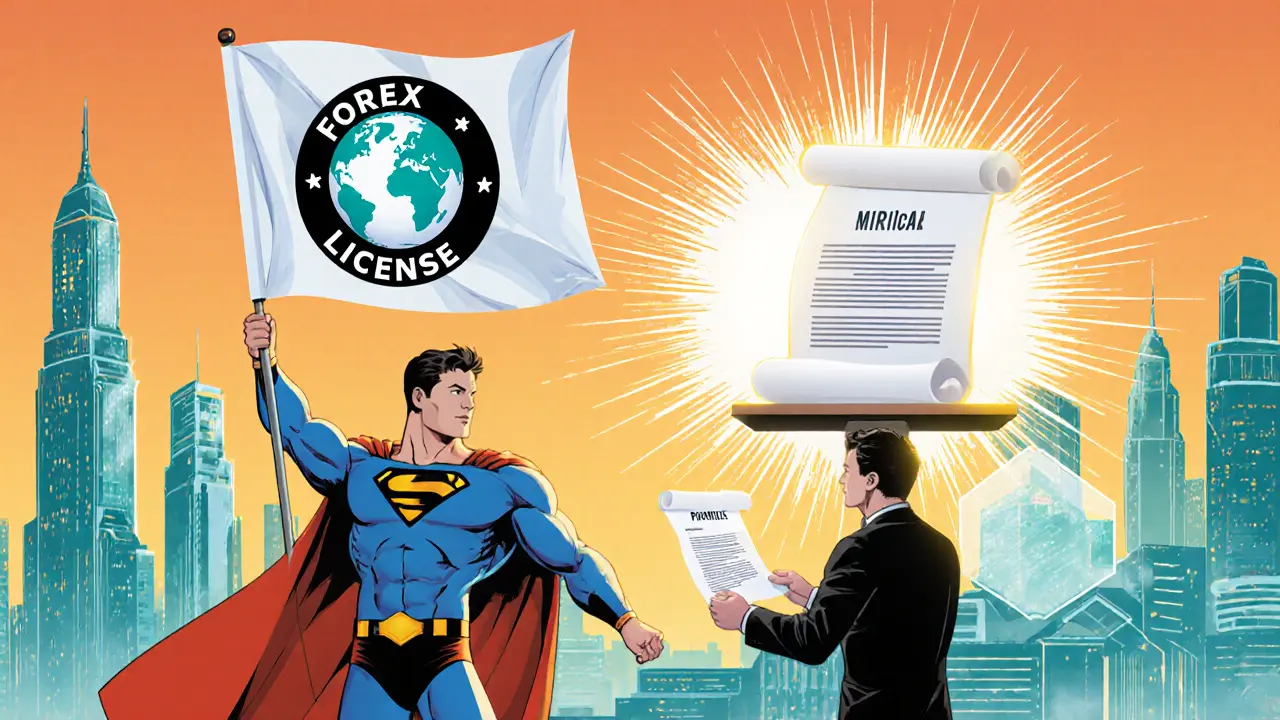
International Forex License Capital Calculator
Calculate Your Minimum Capital Requirement
Enter your target jurisdiction and business model to determine the minimum capital needed for forex licensing.
Enter jurisdiction and business model to see required capital
Key Requirements Comparison
| Country | Capital Requirement | Approval Time | Key Requirements |
|---|---|---|---|
| United States | US $100M (broker-dealers) | 6–9 months | No criminal record, 5+ years experience |
| European Union | €1M (varies by country) | 4–7 months | Clean credit history, fiduciary competence |
| New Zealand | NZ $500K | 3–5 months | Fit-and-proper assessment with AML certification |
Tip: Always maintain a 20% buffer above minimum capital requirements as regulators verify actual funds, not just documentation.
Did you know that over 30% of new fintech firms stall before they even launch because they stumble on the foreign‑exchange licensing maze? If you’re planning to trade currencies, offer payment services, or run a money‑transfer platform across borders, you’ll need an foreign exchange licensing strategy that checks every regulatory box.
International Exchange Licensing is the official permission granted by a country’s financial watchdog-usually the central bank-that allows a business to conduct foreign‑exchange (FOREX) activities such as spot trading, derivatives, or currency conversion for clients. In plain English, it’s the legal green light you need before you can buy, sell, or move money in a currency other than your home one.
Why the License Matters: Risks of Operating Without It
Running a forex operation without a proper license can trigger hefty fines, forced shutdowns, and even criminal charges. Regulators view unlicensed currency trading as a high‑risk activity because it touches anti‑money‑laundering (AML) safeguards, consumer protection, and financial stability. A licensed firm, on the other hand, gains credibility with banks, investors, and customers, and can open foreign‑exchange accounts that are otherwise inaccessible.
Core Elements of a Forex License
- Capital Requirement: Minimum paid‑in capital that varies by jurisdiction (e.g., US $100M, EU €1M, NZ $500K).
- Fit and Proper Test: Background checks on directors and senior managers to ensure integrity and competence.
- Compliance Audit: Ongoing inspections of AML, know‑your‑customer (KYC), and risk‑management procedures.
- Licensing Application: Detailed form submitted to the Central Bank or designated financial authority.
- Anti‑Money Laundering (AML) framework: Policies and technology to detect suspicious transactions.
Step‑by‑Step Process to Secure an International Exchange License
- Define Your Business Model: Are you a broker, a crypto‑fiat gateway, or a payment‑service provider? The model determines which activities need explicit approval.
- Choose the Target Jurisdiction: Consider market size, regulatory friendliness, and where your clients are based.
- Gather Required Documentation:
- Corporate charter and shareholders list.
- Audited financial statements showing the required capital.
- Detailed AML/KYC policies and IT‑security plan.
- Fit‑and‑proper questionnaires for each senior officer.
- Submit the Licensing Application to the relevant Central Bank (e.g., Reserve Bank of New Zealand, Federal Reserve, European Central Bank). Expect a filing fee ranging from $5K to $50K.
- Respond to Regulator Queries: Reviewers often ask for clarifications on risk‑management tools or source‑of‑funds procedures. Prompt, thorough answers speed up approval.
- Pass the Compliance Audit: Once the license is issued, a post‑grant audit checks that your AML system, transaction monitoring, and reporting mechanisms match the regulator’s standards.
- Maintain Ongoing Reporting: Submit quarterly financials, suspicious‑activity reports, and an annual compliance certificate to retain your license.

Comparing Licensing Requirements Across Major Markets
| Jurisdiction | Capital Requirement | Primary Regulator | Typical Approval Time | Fit‑and‑Proper Bar |
|---|---|---|---|---|
| United States | US $100M (for broker‑dealers) | Commodity Futures Trading Commission (CFTC) & National Futures Association (NFA) | 6-9months | No criminal record, minimum 5years relevant experience |
| European Union (MiFID‑II) | €1M (varies by country) | National Financial Authority (e.g., BaFin, FCA) | 4-7months | Clean credit history, fiduciary competence |
| NewZealand | NZ $500K | Reserve Bank of NewZealand (RBNZ) - Financial Markets Authority | 3-5months | Fit‑and‑proper assessment includes AML certification |
Common Pitfalls and How to Avoid Them
- Underestimating Capital Needs: Regulators audit your actual capital, not just the “paper” amount. Keep a buffer of at least 20% above the minimum.
- Weak AML Controls: A single missed SAR (suspicious activity report) can trigger a suspension. Deploy automated transaction monitoring and conduct regular staff training.
- Inadequate Partner Vetting: If you rely on third‑party liquidity providers, they must also be licensed. Include “partner compliance” clauses in contracts.
- Late or Incomplete Documentation: Missing signatures or outdated financials are the quickest ways to stall approval. Use a checklist (see below).
- Ignoring Post‑License Audits: Some firms treat the audit as a formality. In reality, auditors can request system logs, employee records, and client onboarding files at any time.
International Exchange Licensing Checklist
- Identify the exact scope of activities (spot trading, derivatives, payment services).
- Select the target jurisdiction(s) and verify capital thresholds.
- Prepare corporate documents: charter, shareholders, board minutes.
- Compile audited financial statements showing required capital.
- Draft AML/KYC policies aligned with FATF recommendations.
- Complete Fit‑and‑Proper questionnaires for every senior officer.
- Gather IT‑security and data‑protection certificates (ISO27001, GDPR compliance).
- Submit the application with all fees and a signed cover letter.
- Track regulator communications and respond within stipulated timelines.
- Schedule the post‑grant compliance audit and set up internal reporting mechanisms.

Strategic Choices: When to Pursue a License vs. Partnering with a Licensed Provider
If your market is niche and you need direct control over client funds, obtaining a license makes sense despite the cost. However, many startups opt for a white‑label partnership with an existing broker‑dealer, which lets them launch in weeks rather than months, while still staying compliant through the partner’s license. The trade‑off is revenue sharing-typically 10‑20% of trading commissions.
Future Outlook: How Regulation Is Evolving
Regulators worldwide are tightening AML rules and introducing digital‑identity requirements. In the EU, the Markets in Crypto‑Assets (MiCA) regulation will extend licensing obligations to crypto‑fiat platforms starting 2026. NewZealand’s RBNZ is piloting a sandbox for blockchain‑based settlement, allowing licensed firms to test real‑time settlement without full‑scale licensing, but only after a successful pilot.
Next Steps for Your Business
1. Run an internal readiness assessment against the checklist above.
2. Choose a jurisdiction that aligns with your client base and capital capability.
3. Engage a legal counsel experienced in foreign exchange licensing to draft your application.
4. Set up a dedicated compliance team before you submit the paperwork.
5. Plan for post‑license audits from day one.
Frequently Asked Questions
What is the difference between a forex broker license and a payment‑service provider license?
A forex broker license authorizes you to execute buy/sell orders on behalf of clients in the foreign‑exchange market, while a payment‑service provider (PSP) license lets you move money between accounts and process transactions. Some regulators combine the two, but many jurisdictions require separate approvals because the risk profiles differ.
How much capital do I need to start a forex brokerage in NewZealand?
The Reserve Bank of NewZealand mandates a minimum paid‑in capital of NZ $500K for entities that provide exchange services. In practice, most firms hold at least NZ $750K to cover operational costs and regulatory buffers.
Can a fintech startup obtain a licence without a physical office?
Many regulators accept a virtual office if you can demonstrate robust governance, a local director, and secure data centres. However, some jurisdictions (e.g., the US) still require a physical address for the principal place of business.
What are the typical ongoing costs after the licence is granted?
Annual supervisory fees (often 0.02% of capital), compliance staff salaries, AML software subscriptions (US $10‑20K per year), and periodic audit fees (US $15‑30K). Budgeting 5‑7% of your operating budget for regulatory overhead is common.
Is it easier to get a licence in a small market like NewZealand than in the EU?
Generally yes. NewZealand’s RBNZ has a streamlined application form and shorter review periods (3‑5months). The EU’s MiFID‑II framework requires alignment with each member state’s national law, leading to longer timelines and higher capital thresholds.

Ken Lumberg
October 14, 2025 AT 10:42When you ignore the ethical responsibilities of a forex broker, you aren't just cutting corners-you are endangering the financial safety of countless traders who trust the system to protect them from fraud and market abuse.